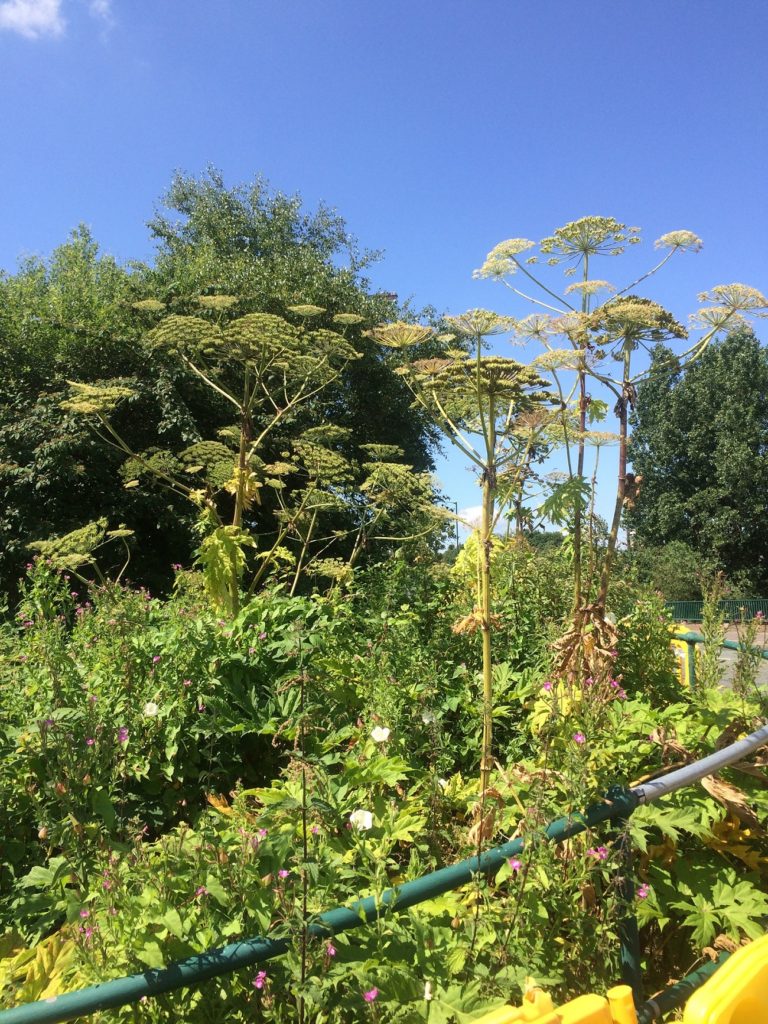
So, the shops have their Christmas trees up and they’re stocking mince pies that will have spoiled long before December, so obviously this is an appropriate time to make a Christmas wish list, right?
Since we have absolutely no interest other than invasive weeds and therefore don’t have the imagination to wish for world peace or some concrete action on biodiversity loss and global warming, our list is fairly short and specific…
Dear Santa
What the invasive weeds industry wants for Christmas:
Better awareness of the problems associated with Giant hogweed, which can cause severe burns, and which injures people across the UK every year, particularly children. Better education and awareness will protect children from really unpleasant and potentially lasting damage – and might even teach them something about the natural world they don’t live in any more.
–
More understanding of the problems Buddleja davidii causes – which are already widely recognised by the rail industry and other specific sectors – and a bit more advice from gardening professionals about when and where this plant is and isn’t appropriate. In the wild, it’s a real pain in the neck, and in part, it is getting there over garden fences.
–
A more nuanced understanding of the old “7m rule” for the spread of Japanese knotweed rhizomes – given this no longer appears in EA guidance, and was always at best a “rule of thumb” for figuring out the worst-case scenario. We would like to see advice and guidance from bodies like RICS updated to better reflect what we find in real world conditions: that JK rhizomes generally extend something like about 4-5m, although obviously this depends on the maturity of the infestation and the soil conditions. The invasive species trade body INNSA’s Japanese Knotweed Code of Practice already has a sensible take on this.
–
Reduction in the scare stories about “structural damage” – which only occurs in rare cases and in certain specific circumstances. Japanese knotweed is much like other plants, and probably less damaging than a lot of tree species. It’s a plant, whose root system will seek out water and whose shoots will seek out light. In almost every case, it will take the path of least resistance. Japanese knotweed doesn’t seek out bricks and mortar and break them up for its dinner.
Conversely, we would like to see a wider understanding of the damage that JK can cause to hard surfaces and new buildings, especially when JK rhizomes are covered over. Problems occur if you ignore Japanese knotweed when laying hard surfaces, particularly tarmac, which the knotweed will grow straight through – or particularly when the path of least resistance is through the built environment – e.g. when you put a concrete slab on top of the plant, and it forces its way round the edges, and through the join between your new conservatory and the back wall of your house. Oops. Or when you build a house on it and the only path to light is through your floorboards. D’oh!
You will also pay the price if you let Japanese knotweed continue to grow behind retaining walls, particularly brick walls, which can be penetrated, distorted, displaced and eventually even brought down by Japanese knotweed plants growing behind them.
–
We would welcome a continuing of the loosening of mortgage lenders’ approach to JK – which has been travelling in the right direction for some years, now – particularly due to continuing good work by industry trade bodies.
Of course, we understand that risk controls are needed, and that these controls are also good for consumers, in the main, but talk of “zero valuations” and valuation write-downs in multiple tens of thousands of pounds would seem to be (mostly) vastly inflated – particularly given how much greater these sums are than the remediation costs, and the relatively low risks of significant damage, as above. Of course, there are odd exceptions, particularly where properties are built on established stands of JK – but again, Invasive Weed Solutions can implement suitable programs to control the problem and return the property to a fully-usable state.
–
Clarity from the courts on what recent cases mean for private homeowners who carry out chemical treatment on Japanese knotweed on their own land. Recent decisions seem to suggest that homeowners could still be taken to court and sued by their neighbours, even after taking the most appropriate measures to remediate the problem.
Removal to landfill is extremely costly and contributes unnecessarily to an increasing environmental problem. It is an appropriate solution in some cases – but very rarely in private gardens.
Anyway, cheers, Santa – good luck fitting all that down the chimney!
Yours sincerely,
Chris Oliver
Invasive Weed Solutions Limited
